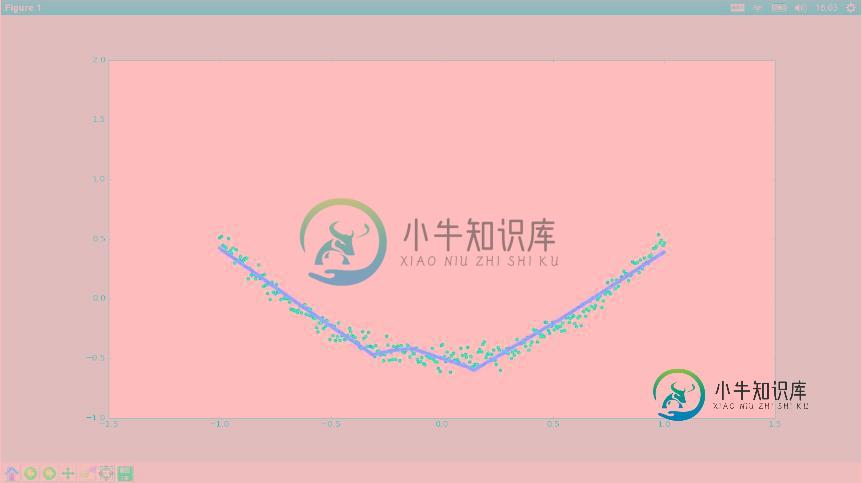tensorflow建立一个简单的神经网络的方法
本笔记目的是通过tensorflow实现一个两层的神经网络。目的是实现一个二次函数的拟合。
如何添加一层网络
代码如下:
def add_layer(inputs, in_size, out_size, activation_function=None):
# add one more layer and return the output of this layer
Weights = tf.Variable(tf.random_normal([in_size, out_size]))
biases = tf.Variable(tf.zeros([1, out_size]) + 0.1)
Wx_plus_b = tf.matmul(inputs, Weights) + biases
if activation_function is None:
outputs = Wx_plus_b
else:
outputs = activation_function(Wx_plus_b)
return outputs
注意该函数中是xW+b,而不是Wx+b。所以要注意乘法的顺序。x应该定义为[类别数量, 数据数量], W定义为[数据类别,类别数量]。
创建一些数据
# Make up some real data x_data = np.linspace(-1,1,300)[:, np.newaxis] noise = np.random.normal(0, 0.05, x_data.shape) y_data = np.square(x_data) - 0.5 + noise
numpy的linspace函数能够产生等差数列。start,stop决定等差数列的起止值。endpoint参数指定包不包括终点值。
numpy.linspace(start, stop, num=50, endpoint=True, retstep=False, dtype=None)[source] Return evenly spaced numbers over a specified interval. Returns num evenly spaced samples, calculated over the interval [start, stop].

noise函数为添加噪声所用,这样二次函数的点不会与二次函数曲线完全重合。
numpy的newaxis可以新增一个维度而不需要重新创建相应的shape在赋值,非常方便,如上面的例子中就将x_data从一维变成了二维。
添加占位符,用作输入
# define placeholder for inputs to network xs = tf.placeholder(tf.float32, [None, 1]) ys = tf.placeholder(tf.float32, [None, 1])
添加隐藏层和输出层
# add hidden layer l1 = add_layer(xs, 1, 10, activation_function=tf.nn.relu) # add output layer prediction = add_layer(l1, 10, 1, activation_function=None)
计算误差,并用梯度下降使得误差最小
# the error between prediciton and real data loss = tf.reduce_mean(tf.reduce_sum(tf.square(ys - prediction),reduction_indices=[1])) train_step = tf.train.GradientDescentOptimizer(0.1).minimize(loss)
完整代码如下:
from __future__ import print_function
import tensorflow as tf
import numpy as np
import matplotlib.pyplot as plt
def add_layer(inputs, in_size, out_size, activation_function=None):
# add one more layer and return the output of this layer
Weights = tf.Variable(tf.random_normal([in_size, out_size]))
biases = tf.Variable(tf.zeros([1, out_size]) + 0.1)
Wx_plus_b = tf.matmul(inputs, Weights) + biases
if activation_function is None:
outputs = Wx_plus_b
else:
outputs = activation_function(Wx_plus_b)
return outputs
# Make up some real data
x_data = np.linspace(-1,1,300)[:, np.newaxis]
noise = np.random.normal(0, 0.05, x_data.shape)
y_data = np.square(x_data) - 0.5 + noise
# define placeholder for inputs to network
xs = tf.placeholder(tf.float32, [None, 1])
ys = tf.placeholder(tf.float32, [None, 1])
# add hidden layer
l1 = add_layer(xs, 1, 10, activation_function=tf.nn.relu)
# add output layer
prediction = add_layer(l1, 10, 1, activation_function=None)
# the error between prediciton and real data
loss = tf.reduce_mean(tf.reduce_sum(tf.square(ys - prediction),
reduction_indices=[1]))
train_step = tf.train.GradientDescentOptimizer(0.1).minimize(loss)
# important step
init = tf.initialize_all_variables()
sess = tf.Session()
sess.run(init)
# plot the real data
fig = plt.figure()
ax = fig.add_subplot(1,1,1)
ax.scatter(x_data, y_data)
plt.ion()
plt.show()
for i in range(1000):
# training
sess.run(train_step, feed_dict={xs: x_data, ys: y_data})
if i % 50 == 0:
# to visualize the result and improvement
try:
ax.lines.remove(lines[0])
except Exception:
pass
prediction_value = sess.run(prediction, feed_dict={xs: x_data})
# plot the prediction
lines = ax.plot(x_data, prediction_value, 'r-', lw=5)
plt.pause(0.1)
运行结果:

以上就是本文的全部内容,希望对大家的学习有所帮助,也希望大家多多支持小牛知识库。
-
本文向大家介绍tensorflow构建BP神经网络的方法,包括了tensorflow构建BP神经网络的方法的使用技巧和注意事项,需要的朋友参考一下 之前的一篇博客专门介绍了神经网络的搭建,是在python环境下基于numpy搭建的,之前的numpy版两层神经网络,不能支持增加神经网络的层数。最近看了一个介绍tensorflow的视频,介绍了关于tensorflow的构建神经网络的方法,特此记录。
-
本文向大家介绍tensorflow入门之训练简单的神经网络方法,包括了tensorflow入门之训练简单的神经网络方法的使用技巧和注意事项,需要的朋友参考一下 这几天开始学tensorflow,先来做一下学习记录 一.神经网络解决问题步骤: 1.提取问题中实体的特征向量作为神经网络的输入。也就是说要对数据集进行特征工程,然后知道每个样本的特征维度,以此来定义输入神经元的个数。 2.定义神经网络的结
-
我正在建立一个简单的神经网络。数据是一个231长的向量,它是一个热编码的向量。每个231个长向量被分配一个8个长的热编码标签。 到目前为止,我的代码是: 问题是输出层是8个单位,但是我的标签不是单个单位,它们是一个热编码的8个长矢量。如何将此表示为输出? 错误消息是: 无法用非浮点dtype构建密集层 完全回溯:
-
本文向大家介绍TensorFlow实现简单卷积神经网络,包括了TensorFlow实现简单卷积神经网络的使用技巧和注意事项,需要的朋友参考一下 本文使用的数据集是MNIST,主要使用两个卷积层加一个全连接层构建的卷积神经网络。 先载入MNIST数据集(手写数字识别集),并创建默认的Interactive Session(在没有指定回话对象的情况下运行变量) 在定义一个初始化函数,因为卷积神经网络有
-
我试图用TensorFlow建立一个简单的神经网络。目标是在32像素x 32像素的图像中找到矩形的中心。矩形由五个向量描述。第一个向量是位置向量,其他四个是方向向量,组成矩形边。一个向量有两个值(x和y)。 该图像的相应输入为(2,5)(0,4)(6,0)(0,-4)(-6,0)。中心(以及所需输出)位于(5,7)。 我想出的代码如下所示: 遗憾的是,网络无法正常学习。结果太离谱了。例如,[[3.
-
本文向大家介绍利用TensorFlow训练简单的二分类神经网络模型的方法,包括了利用TensorFlow训练简单的二分类神经网络模型的方法的使用技巧和注意事项,需要的朋友参考一下 利用TensorFlow实现《神经网络与机器学习》一书中4.7模式分类练习 具体问题是将如下图所示双月牙数据集分类。 使用到的工具: python3.5 tensorflow1.2.1 numpy matp

